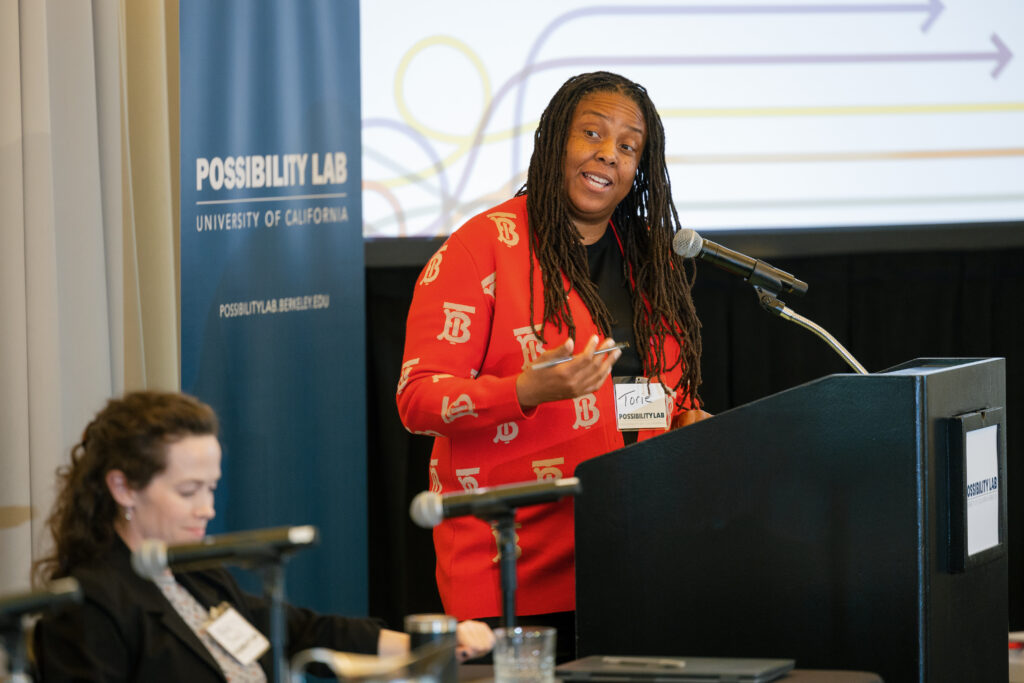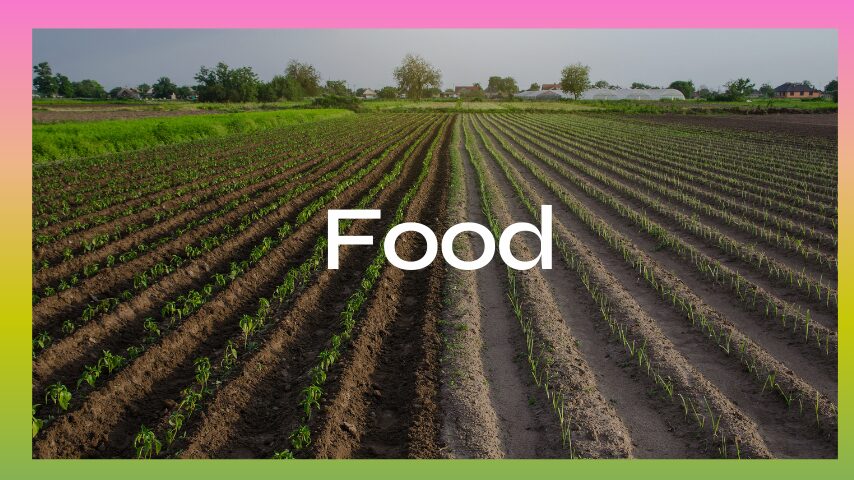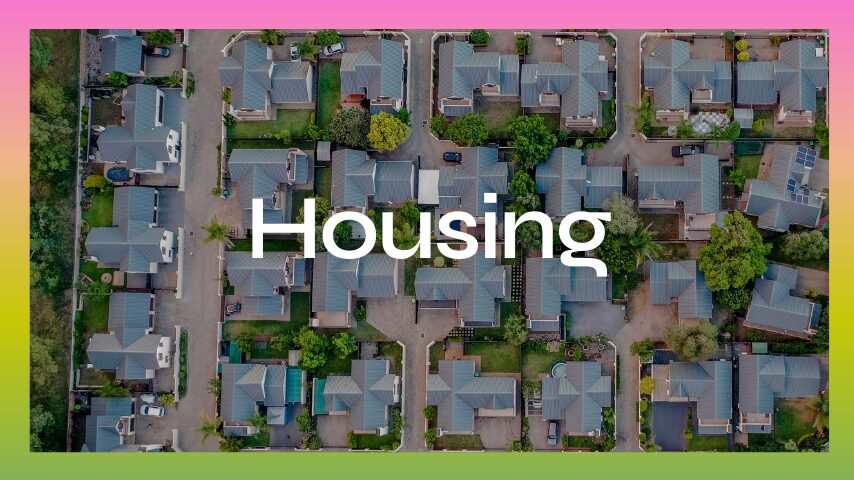
Abundance Accelerator
Together with a growing network of partners, the Possibility Lab’s Abundance Accelerator initiative is leveraging applied research and community-building to promote government policies that expand California’s capacity to sustainably supply essential resources, goods, and services to its people.

CalMatters Op-Ed
Achieving the ‘abundance agenda’ in California will require more than just efficiency”
Read the Op-Ed by our Executive Director and Director of Projects and Planning
OUR PRINCIPLES
We Believe In A People-Centered Approach To Abundance
Our abundance work seeks to identify opportunities to support and invest in communities, workers, and state capacity.
Since the Summer of 2023, we have been building out our theory of abundance in practice and defining our associated abundance principles. Though certainly a work in progress, these nine principles reflect an emergent framework for implementing the Abundance Agenda that integrates the ethos of the national abundance movement and the core values of the Possibility Lab’s people-centered approach.

Abundance requires a mindset shift.
An abundance mindset holds that there can be sufficient resources to provide high-quality necessities and opportunities for all. California enjoys vast abundance, in terms of both natural resources and human resourcefulness. We have enough of what we need in many domains, but we often lack the right policies and programs to translate the state’s natural abundance of resources and people into the effective delivery of human essentials. By applying an abundance mindset to public policy, we can move beyond zero-sum thinking in politics and embrace the idea that “a rising tide lifts all boats.”
Abundance requires supply-side policy reform.
The Abundance Agenda proposes policy reforms that will harness the supply side of the economy to produce enough essential goods and services so that each of us gets what we need. In theory, when products are available in abundance, sellers are compelled to reduce prices to be able to competitively sell what they produce. But when there are limitations on production (either real or artificial), sellers are able to raise prices and still make sales. While demand-side policy that subsidizes consumer spending can provide relief in the short term, supply-side policy that addresses underlying supply constraints can address the root causes of scarcity in the longer term. The Abundance Agenda focuses on strengthening the supply side to improve the availability, accessibility, and affordability of basic human essentials.
Abundance requires environmental consciousness.
An environmental consciousness recognizes the importance of preserving and replenishing natural resources to ensure abundance for generations to come. Because most natural resources are finite, the Abundance Agenda must design policy so that increases in the supply of human essentials do not exceed the ecological boundaries of the planet. Through environmentally conscious policy design, the Abundance Agenda can transform California’s approach to development through the creation of circular economies in which products and infrastructure are designed for durability, reuse, and recyclability while minimizing waste and pollution. Moreover, an environmentally conscious approach to abundance can ensure supply-side policies that promote renewable energy, ecosystem restoration, and soil health.
Abundance requires equitable access.
Because lower-income individuals typically spend a greater portion of their budgets on necessities, policies that increase the supply and affordability of necessities tend to benefit disadvantaged groups more than they benefit the wealthy. Moreover, when funded through public investment via progressive taxation and paired with effective distribution, supply-side policy can further promote equity. With this operational understanding of equity in mind, the Abundance Agenda generally does not include policies that explicitly target benefits to particular demographic groups. Instead, the operating principle is that public policy should promote broad-based economic improvements that, by virtue of their funding and distributional structure, disproportionately benefit the disadvantaged. To advance equity over the long haul, California needs this kind of broad-based, equitable supply-side reform.
Abundance requires policymaking for the common good.
The Abundance Agenda advocates for reforms that minimize narrow interest group capture and promote the common good. Interest groups themselves are not necessarily problematic, and there are many variations of interest group capture, ranging from NIMBYs to unions to corporate actors, and beyond. But interest group capture is facilitated, in part, by government processes that give back-end veto-power to minoritarian interests. As a result, narrow interests too often delay or block projects and can push electeds towards policies that stifle implementation. By accommodating the demands of narrow interests and saddling public programs with too many requirements, “everything-bagel” policies try to appease every interest within every project and thereby undermine the efficacy of public programs to the detriment of the common good. Given the acute problem of scarcity in California, the Abundance Agenda must implement reforms that overcome interest group capture and catalyze the rapid buildout of human essentials.
Abundance requires building community buy-in.
The problem of scarcity in California necessitates immediate action; however, moving fast should not sideline deep and meaningful community engagement. In order to successfully implement an abundance framework, we must do the ongoing work of building community buy-in and bringing impacted people together to facilitate decision-making. This aspect of the Abundance Agenda requires the development of more meaningful and inclusive processes of community engagement that expand front-end participation and ensure that moving fast doesn’t come at the expense of being fair. To expand the supply of human essentials, the Abundance Agenda encourages the use of new techniques and technologies that facilitate broad-based community input at the early stages of development timelines and throughout project life cycles.
Abundance requires strengthening state capacity.
The success of the Abundance Agenda requires building capacity throughout all levels of government to effectively implement public policy. The high prevalence of strict procedural requirements in administrative law hobbles the ability of government agencies to adapt, improve, and deliver better outcomes. Moreover, California has outsourced various government functions to contractors and nonprofits without an overwhelming improvement in outcomes, culminating in a weakened public sector that struggles to attract and retain talented public servants. In contrast, the Abundance Agenda promotes reforms that can provide the public sector with the flexibility and resources needed to create better systems, the well-trained and well-supported personnel to achieve complex policy goals, and feedback loops that use evidence and data to solve pressing problems. Furthermore, the goal of these reforms would result in lightening the regulatory burden that the government has imposed on itself and the private sector, in a way that balances taxpayer protections while empowering government employees to focus their time and energy on tangible outcomes.
Abundance requires collaboration and innovation between the public and private sectors.
The Abundance Agenda promotes collaboration between the public and private sectors to catalyze innovation towards the provision of basic human essentials. To promote collaboration, we can implement funding mechanisms that align the incentives of private enterprise with the needs of the public. These mechanisms might include an effective combination of “push” and “pull” funding, as well as advance market commitments, through which the state helps cover the early expenses of development then rewards successful outcomes, all while mitigating demand uncertainty. In addition, the state can thoughtfully streamline regulatory processes to encourage public-private collaboration in the provision of human essentials. And further, the state can foster partnerships between philanthropy, nonprofits, and local governments to fund and implement projects that are tailored to community-specific needs.
Abundance requires investing in communities, workers, and the civil service.
To build or to care, we need people. Achieving abundance requires investing in communities, workers, and the civil service for at least two reasons. First, the problem of scarcity in California is often related to shortages in the supply of personnel who are trained and authorized to provide essential services. To achieve abundance in California, we need to invest in the workforce that provides these services. Second, investing in people is critical for ensuring that abundance translates to shared prosperity. An end-result of “more” means little if people are not uplifted in the process. To ensure that the Abundance Agenda delivers shared prosperity from the bottom-up, we need to design abundance policy so that it invests in people at every stage.

Abundance Accelerator Summit [REPLAY]
Beyond Scarcity: The Summit to Advance an Abundant California
Our Research
Our Consortium

Consortium Members
-

-
Anna Powell
Childcare Expert
-

-
Edward Helderop
Digital Connectivity Expert
-

-
Carrie Hahnel
Education Expert
-

-
Mireille Jacobson
Eldercare Expert
-

-
Anibel Ferus-Comelo
Employment Expert
-

-
Keith Taylor
Energy Expert
-

-
Anastasia Telesetsky
Food Expert
-

-
Leif Haase
Healthcare Expert
-

-
Paavo Monkkonen
Housing Expert
-

-
Mikaela Rabinowitz
Safety Expert
-

-
Juan Matute
Transportation Expert
-

-
Nicola Ulibarri
Water Expert

Developing an Abundance Agenda for California
There are a vast array of potential policy interventions, at many different levels and sites of government, that align with an abundance framework. Our approach to moving from conceptual framework to policy agenda is to start with fundamental human needs. We believe every Californian should be able to readily access 12 human essentials.
12 Human Essentials












Abundance Accelerator